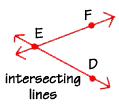
 |
| Home | Teacher | Parents | Glossary | About Us | |||||||||||
|
|
|||||||||||
|
|
The world is made of many things. Some can be touched, counted, or seen. There are other things that exist only in the imagination, but these imaginary things can be very powerful tools! You can see geometry everywhere around you, in manmade structures, in nature, in sports, in manufacturing, and in art. In geometry there are only four imaginary items—simple ideas—upon which everything else is built: point, line, plane, and space.
![]()
The most important thing to remember about a point is that it has absolutely no dimensions—no length, no width, no depth. It is simply a location. We use a dot, like point N shown here, to symbolize a point, but a dot is not a true point because any written or printed dot, no matter how small, has dimensions.

A line is a set of points that has only one dimension, length. Think of multitudes of points lying on a single path. Points on the same line are called "collinear points." Two points are needed to define a line.
Notice how to write the symbol for this line. The arrowheads on line DE show us that the line extends endlessly in both directions—it has no endpoints. When two lines meet at a point, they are called "intersecting lines."

The set of points called a plane lies all on one surface. In algebra, you've already used the coordinate plane for plotting points, so you're familiar with at least one example of a plane. The surface of a table is another example of a plane—but a plane actually extends endlessly.
Also, remember that the surface of a plane has no thickness. At least three points not on the same line are needed to define a plane.

Finally, there is space, the set of all points. It's difficult to illustrate the idea of space, since it's everywhere! You can think of it as an open, empty room, or the inside of an empty box. Space has no boundaries and extends endlessly in all directions.
Of course, these four terms are just the beginning. You'll encounter many more words and their meanings as you work through this geometry course. Before you move on, here are three more basic terms to become familiar with. You'll be seeing them often.
Line segment
A line segment is simply a part of a line that has a specific length and specific endpoints. Notice the symbol for a line segment. How is it different from the symbol for a line?
Two line segments that have the same length are called congruent segments. This symbol is used to show congruence.
![]()

Ray
A ray is a part of a line that has only one endpoint. It extends endlessly in one direction. Notice the symbol for a ray. How is it different from the symbol for a line and a line segment?

Angle
Two rays joined with a common endpoint form an angle. The common endpoint is called a vertex.

| Homework Help | Geometry | Geometry Building Blocks | |||
|
|
||||||||||||||||||||||||||||||||||||||||||||||||||||||||||||